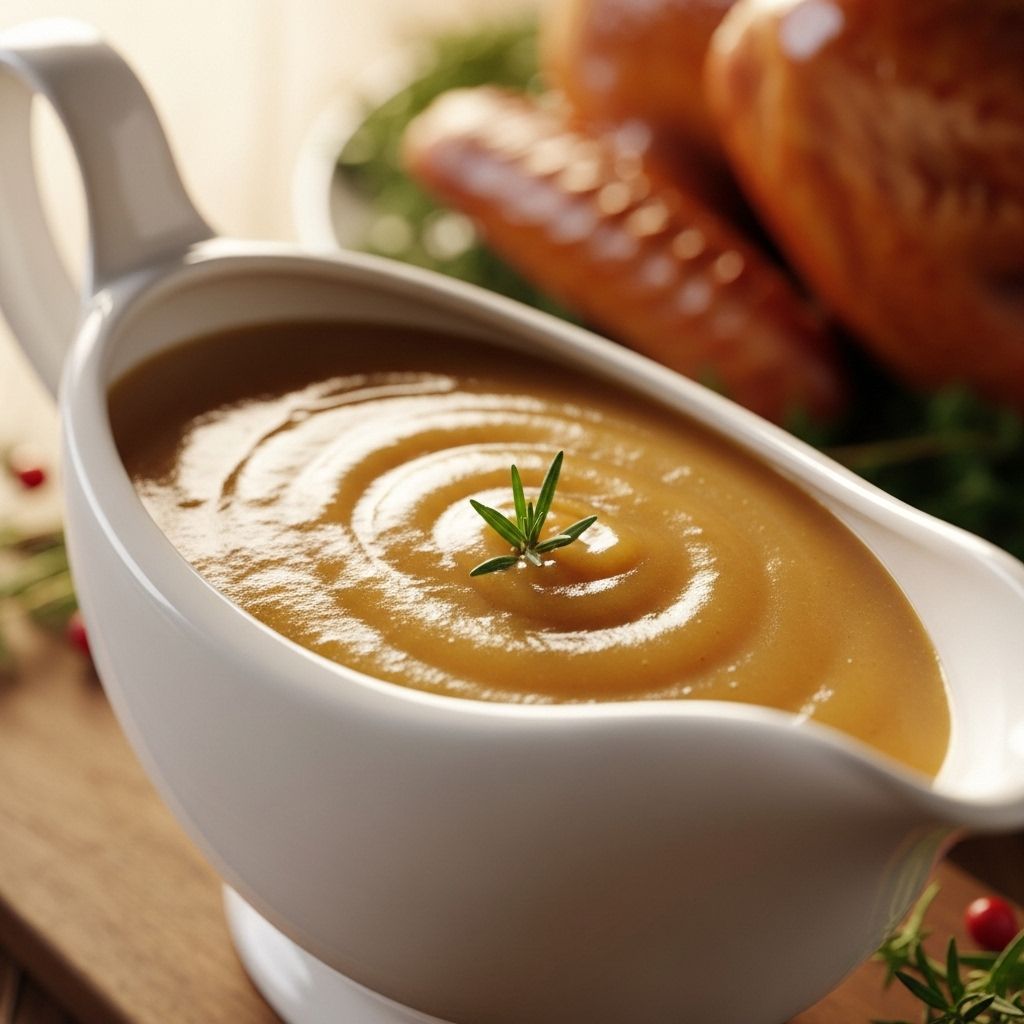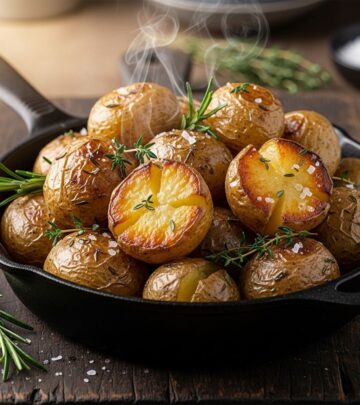Simple Turkey Gravy: The Ultimate Guide for Rich, Homemade Flavor
A velvety sauce that transforms leftover drippings into crowd-pleasing flavor.

Image: HearthJunction Design Team
Simple Turkey Gravy: The Ultimate Homemade Classic
Nothing completes a roasted turkey quite like a rich, homemade turkey gravy. This easy method transforms flavorful pan drippings and turkey stock into a smooth, golden sauce ideal for every holiday or family meal. Whether it’s Thanksgiving, Christmas, or Sunday dinner, classic turkey gravy made from scratch elevates your table and satisfies every guest.
Table of Contents
- About This Recipe
- Ingredients
- Step-by-Step Instructions
- Expert Tips for Perfect Turkey Gravy
- Popular Variations
- Troubleshooting & Fixes
- Serving Suggestions
- Storing & Reheating
- Frequently Asked Questions (FAQs)
About This Recipe
Turkey gravy is a staple of festive tables, known for its savory depth and comforting texture. This simple turkey gravy is easy enough for beginners yet delivers exceptional flavor. By using flavorful pan drippings and turkey stock, you create a custom gravy that’s richer and more vibrant than anything store-bought. The process takes only about 15 minutes after your turkey is done resting, making it the perfect finishing touch for your feast.
Ingredients
To make basic turkey gravy, you will need:
- Pan drippings from roasted turkey (with fat separated)
- Turkey stock (or chicken broth)
- All-purpose flour
- Salt & black pepper, to taste
- Optional: fresh herbs (parsley, thyme, sage)
| Ingredient | Typical Amount | Notes |
|---|---|---|
| Pan Drippings | 1/4 cup fat, plus drippings | Separate fat to make roux; reserve extra for flavor. |
| Turkey Stock | 2–3 cups | Use as needed to reach your preferred gravy thickness. |
| All-Purpose Flour | 1/4 cup | For thickening gravy. |
| Salt & Pepper | To taste | Season at the end for best flavor control. |
| Fresh Herbs (optional) | 1–2 tbsp chopped | Add for aroma and extra depth. |
Step-by-Step Instructions
- Collect Pan Drippings:
After roasting the turkey, pour the drippings into a clear measuring cup or fat separator. Let stand; the fat will rise. Spoon or pour off 1/4 cup of fat to make the roux. Reserve both the fat and the defatted juices.
- Make the Roux:
In a large saucepan or skillet over medium heat, add the reserved fat. Stir in the flour and whisk constantly. Cook for 2–3 minutes until the mixture turns golden and smells slightly nutty, ensuring there are no lumps (this forms the base for your gravy).
Hoping to add a new dimension to your turkey gravy? Explore our ultimate guide to rich and creamy turkey gravy with fresh herbs. Infusing your dish with aromatic herbs can truly elevate its flavor profile and delight the senses. - Add Broth and Drippings:
Gradually pour in the turkey stock and the remaining defatted pan drippings. Continue to whisk, scraping up any browned bits from the pan—these are packed with flavor.
- Simmer and Thicken:
Bring the mixture to a boil, then reduce heat to a simmer. Continue to whisk frequently for 5–10 minutes as the gravy thickens to your desired consistency.
- Season and Serve:
Taste the gravy and season with salt and pepper as needed. Stir in chopped fresh herbs if desired. Strain the gravy if you prefer an ultra-smooth texture.
Expert Tips for Perfect Turkey Gravy
- Separate fat carefully to avoid oily gravy and ensure a smooth roux.
- Whisk constantly when making the roux and adding liquid—this prevents lumps and creates a silky sauce.
- Simmer the gravy gently. Too vigorous a boil can break the emulsion and cause grease to separate.
- Taste before seasoning—pan drippings can already be salty, so adjust at the end.
- Strain if needed through a fine-mesh sieve for extra-smooth gravy, especially if your drippings contain bits.
- Double or triple the recipe for large gatherings, keeping the roux and liquid ratio consistent.
Popular Variations
- Giblet Gravy: Simmer chopped turkey giblets (neck, heart, gizzard) and add to the finished gravy for a hearty texture.
- Herb-Infused Gravy: Add fresh sage, thyme, or rosemary to the simmering broth for enhanced aroma.
- Creamy Gravy: Stir in a splash of heavy cream just before serving for a richer, velvety finish.
- Wine-Enhanced: Deglaze the pan with dry white wine before adding stock and drippings for a subtle complexity.
- Gluten-Free: Use cornstarch or a gluten-free flour blend as a thickener instead of all-purpose flour.
Troubleshooting & Fixes
| Problem | Solution |
|---|---|
| Gravy is too thin | Simmer longer, or mix 1 tbsp flour with 2 tbsp cold water and whisk in gradually |
| Gravy is too thick | Whisk in extra warm stock or water, gradually |
| Lumpy texture | Blend with a hand blender or strain through a fine-mesh sieve |
| Oily/greasy gravy | Skim excess fat from the surface |
| Bland flavor | Add salt, pepper, a splash of soy sauce, or boost with bouillon |
| Too salty | Thin with unsalted broth, or add a peeled potato and simmer—remove before serving |
Serving Suggestions
- Serve turkey gravy poured over sliced roast turkey, mashed potatoes, stuffing, or on the side for dipping.
- Drizzle over roasted root vegetables or savory bread puddings for extra flavor.
- Pair with leftover sandwiches by dipping the bread for added moisture and taste.
Storing & Reheating
- Refrigeration: Cool gravy to room temperature, then store in an airtight container for up to 3 days.
- Freezing: Freeze in small portions for up to 3 months. Thaw overnight in the refrigerator before reheating.
- Reheating: Warm over medium-low heat, whisking gently and adding a splash of broth if the gravy is too thick.
Frequently Asked Questions (FAQs)
Can I make turkey gravy ahead of time?
Yes, you can prepare turkey gravy in advance using turkey or chicken stock. On the big day, simply reheat and whisk in pan drippings to boost the flavor. This is especially helpful for busy holiday cooks.
What if I don’t have enough pan drippings?
Use a combination of turkey stock and a bit of butter or oil. If needed, add a spoonful of roasted poultry seasoning or bouillon for a flavor boost.
Can turkey gravy be made gluten free?
Absolutely. Substitute cornstarch for flour to thicken. Mix 1 tablespoon of cornstarch with 2 tablespoons of cold water to make a slurry, then whisk into simmering broth and drippings.
How do I prevent lumpy gravy?
Always whisk flour (or thickener) into hot fat before adding liquid; add broth gradually, whisking constantly. If you get lumps, blend or strain before serving.
Is turkey gravy good for leftovers?
Turkey gravy is delicious poured over hot turkey sandwiches, as a dip for rolls, or spooned onto leftover mashed potatoes and stuffing. It revives refrigerator meals with savory flavor and moisture.
Can I freeze leftover turkey gravy?
Yes! Let gravy cool, then transfer to freezer-safe containers, leaving some space for expansion. Reheat straight from frozen on the stovetop, adding broth if needed to restore texture.
Conclusion
Homemade turkey gravy brings warmth and richness to your holiday table. With just a few simple ingredients and these easy, flexible steps, anyone can create a flavorful gravy that pairs perfectly with turkey and all your favorite sides. Keep these tips and troubleshooting tricks handy for stress-free, delicious results every time you gather with loved ones.
References
- https://www.allrecipes.com/recipe/93243/perfect-turkey-gravy/
- https://www.allrecipes.com/recipe/215325/the-best-turkey-gravy/
- https://www.allrecipes.com/recipe/255731/homemade-turkey-gravy/
- https://www.allrecipes.com/recipe/239434/simple-turkey-gravy/
- https://www.allrecipes.com/recipe/13527/savory-turkey-gravy/
Read full bio of Anjali Sayee












